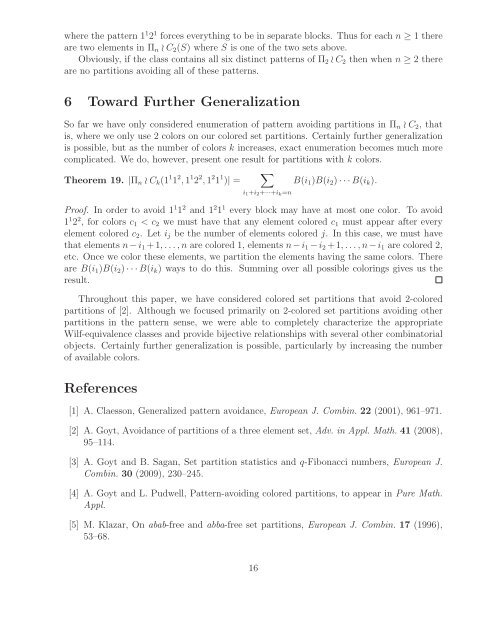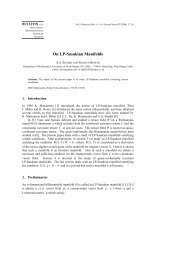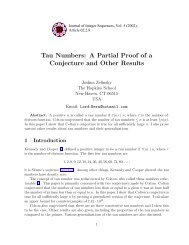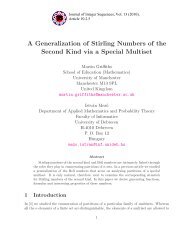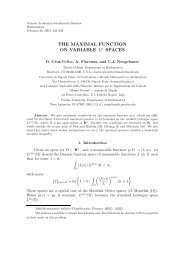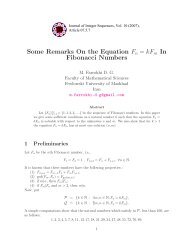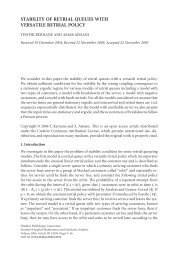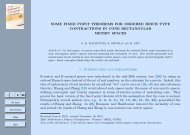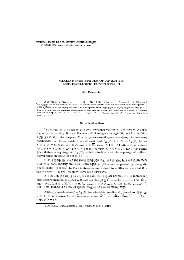Avoiding Colored Partitions of Two Elements in the Pattern Sense
Avoiding Colored Partitions of Two Elements in the Pattern Sense
Avoiding Colored Partitions of Two Elements in the Pattern Sense
Create successful ePaper yourself
Turn your PDF publications into a flip-book with our unique Google optimized e-Paper software.
where <strong>the</strong> pattern 1 1 2 1 forces everyth<strong>in</strong>g to be <strong>in</strong> separate blocks. Thus for each n ≥ 1 <strong>the</strong>reare two elements <strong>in</strong> Π n ≀ C 2 (S) where S is one <strong>of</strong> <strong>the</strong> two sets above.Obviously, if <strong>the</strong> class conta<strong>in</strong>s all six dist<strong>in</strong>ct patterns <strong>of</strong> Π 2 ≀ C 2 <strong>the</strong>n when n ≥ 2 <strong>the</strong>reare no partitions avoid<strong>in</strong>g all <strong>of</strong> <strong>the</strong>se patterns.6 Toward Fur<strong>the</strong>r GeneralizationSo far we have only considered enumeration <strong>of</strong> pattern avoid<strong>in</strong>g partitions <strong>in</strong> Π n ≀ C 2 , thatis, where we only use 2 colors on our colored set partitions. Certa<strong>in</strong>ly fur<strong>the</strong>r generalizationis possible, but as <strong>the</strong> number <strong>of</strong> colors k <strong>in</strong>creases, exact enumeration becomes much morecomplicated. We do, however, present one result for partitions with k colors.∑Theorem 19. |Π n ≀ C k (1 1 1 2 , 1 1 2 2 , 1 2 1 1 )| = B(i 1 )B(i 2 ) · · ·B(i k ).i 1 +i 2 +···+i k =nPro<strong>of</strong>. In order to avoid 1 1 1 2 and 1 2 1 1 every block may have at most one color. To avoid1 1 2 2 , for colors c 1 < c 2 we must have that any element colored c 1 must appear after everyelement colored c 2 . Let i j be <strong>the</strong> number <strong>of</strong> elements colored j. In this case, we must havethat elements n −i 1 +1,...,n are colored 1, elements n −i 1 −i 2 +1,...,n −i 1 are colored 2,etc. Once we color <strong>the</strong>se elements, we partition <strong>the</strong> elements hav<strong>in</strong>g <strong>the</strong> same colors. Thereare B(i 1 )B(i 2 ) · · · B(i k ) ways to do this. Summ<strong>in</strong>g over all possible color<strong>in</strong>gs gives us <strong>the</strong>result.Throughout this paper, we have considered colored set partitions that avoid 2-coloredpartitions <strong>of</strong> [2]. Although we focused primarily on 2-colored set partitions avoid<strong>in</strong>g o<strong>the</strong>rpartitions <strong>in</strong> <strong>the</strong> pattern sense, we were able to completely characterize <strong>the</strong> appropriateWilf-equivalence classes and provide bijective relationships with several o<strong>the</strong>r comb<strong>in</strong>atorialobjects. Certa<strong>in</strong>ly fur<strong>the</strong>r generalization is possible, particularly by <strong>in</strong>creas<strong>in</strong>g <strong>the</strong> number<strong>of</strong> available colors.References[1] A. Claesson, Generalized pattern avoidance, European J. Comb<strong>in</strong>. 22 (2001), 961–971.[2] A. Goyt, Avoidance <strong>of</strong> partitions <strong>of</strong> a three element set, Adv. <strong>in</strong> Appl. Math. 41 (2008),95–114.[3] A. Goyt and B. Sagan, Set partition statistics and q-Fibonacci numbers, European J.Comb<strong>in</strong>. 30 (2009), 230–245.[4] A. Goyt and L. Pudwell, <strong>Pattern</strong>-avoid<strong>in</strong>g colored partitions, to appear <strong>in</strong> Pure Math.Appl.[5] M. Klazar, On abab-free and abba-free set partitions, European J. Comb<strong>in</strong>. 17 (1996),53–68.16


